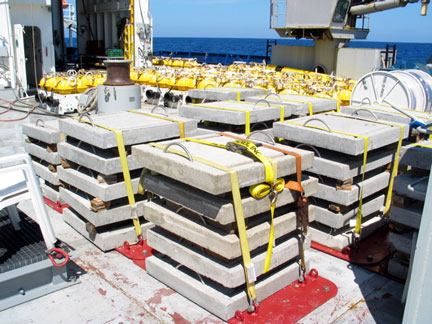Instruments | EM Receiver | Anchor Specifications
To sink the instrument and hold it stable on the seafloor, we use a concrete
anchor approximately 1 m square and 8 cm thick having an air weight of slightly
over 200 kg. The instrument is held onto the anchor by passing a stainless
steel strap through the two loops cast into the anchor. The loop assembly
is simply made of two half-circles of bar welded onto two flat bars to maintain
the spacing and provide a modicum of reinforcing. No other reinforcing is
necessary. The loop assembly must be made of non-magnetic material, usually
non-magnetic stainless steel. The two grooves in the top surface prevent
lateral motion of the instrument when it is mounted on the anchor. The sides
of the anchor may be bevelled for easier release from the mould, or may be
straight.
Download the anchor specs below by clikcing on the drawing names:
Drawing # 15-003: updated
drawing with the new dimension of 32 x 32" to
simplify the parts manufacturing for the internal cross members. All are
now the same length. The internal frame now rests on the base of the mold to
allow for a simpler concrete pouring approach, no longer does it need to be
held up off the base. The height of the concrete was adjusted to maintain the
anchor weight. The loops have a slightly smaller diameter to prevent capturing
the release cable in the corners. But the overall loop height above the concrete
remains the same.
Drawing # 15-002: some
of the same adjustment were made for the old anchor dimensions for people with
the old wood molds.

A concrete "sea slab" anchor on deck inside a steel launch plate.
The launch plate serves to secure the anchor on deck while the instrument frame
is placed
on
top and readied for deployment.

Stacks of anchors five high are secured to the ship's deck using red colored
metal plates and aircraft straps.
|